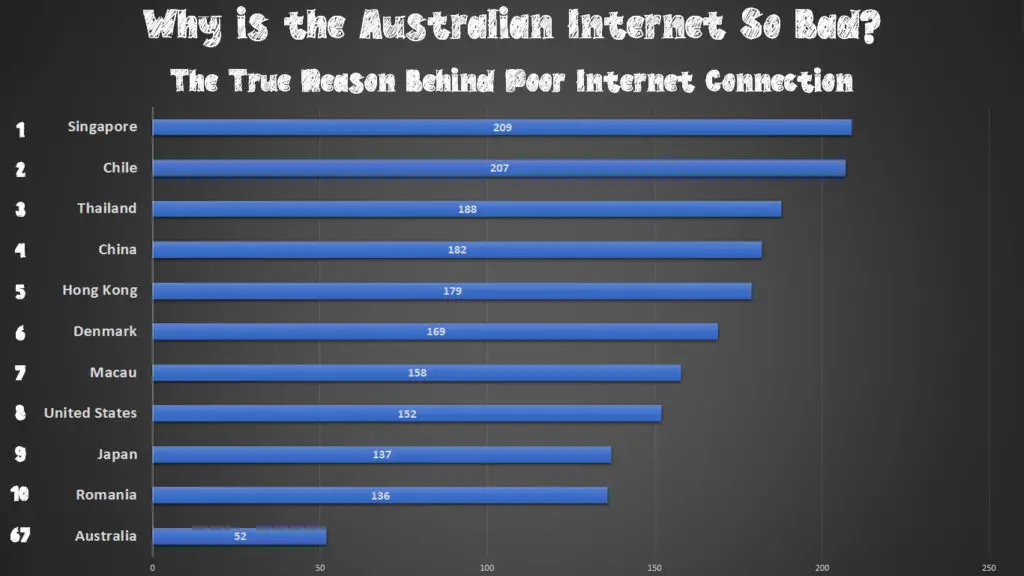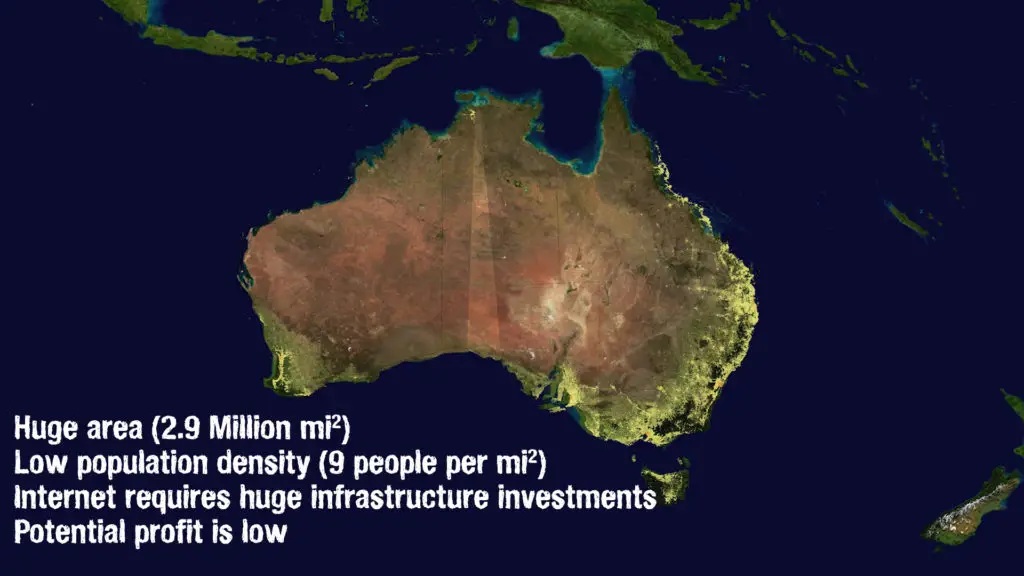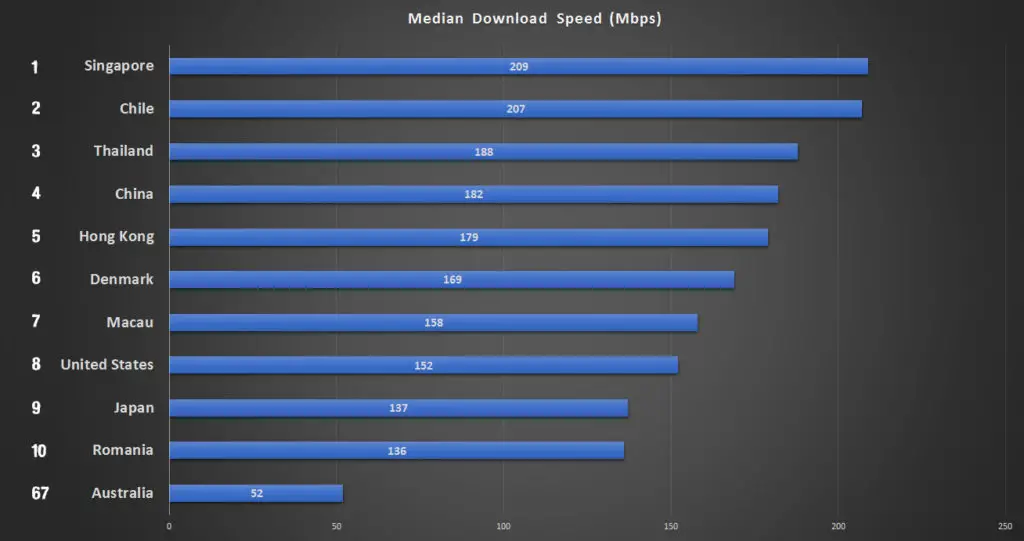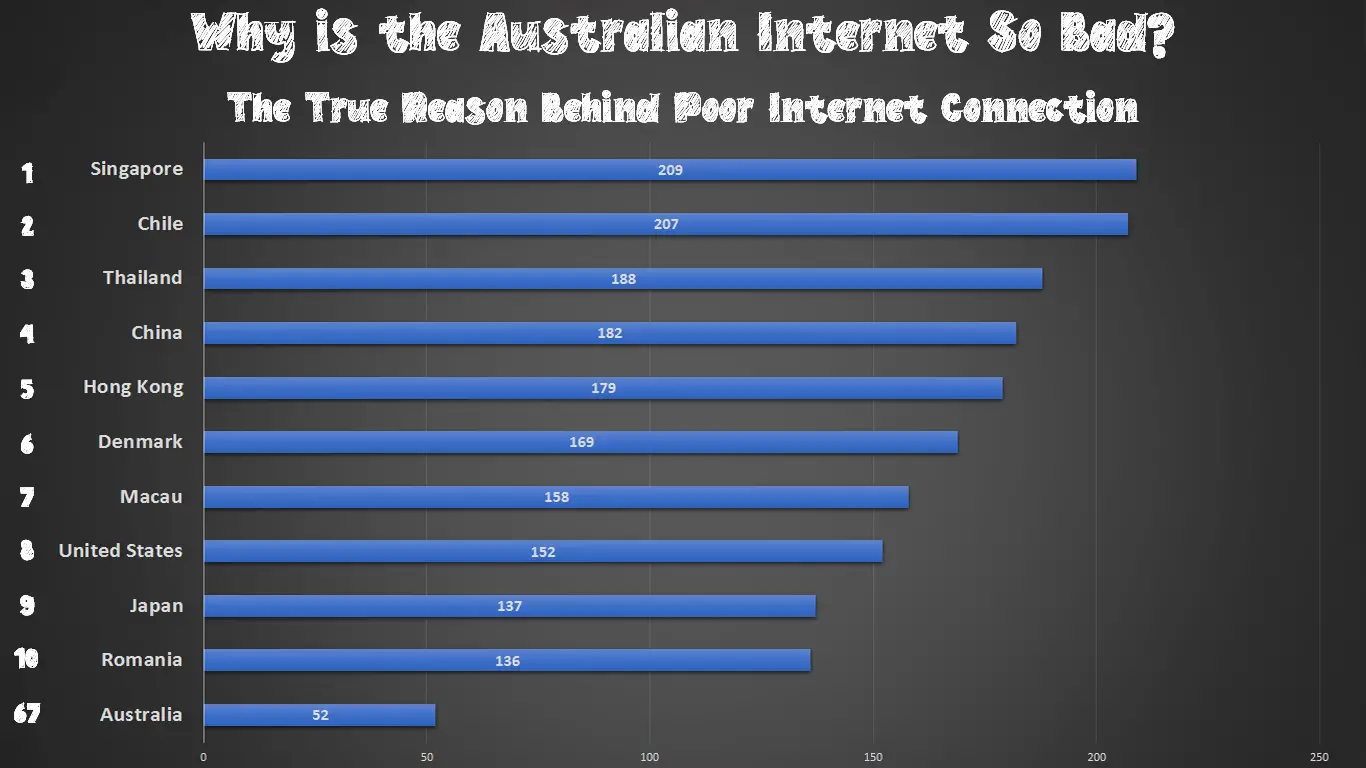According to the latest data available, Australia has the worst internet connection out of all developed countries. The Organisation for Economic Co-operation and Development ranked Australia 68th out of 177 countries worldwide when it comes to the quality of the internet and available speeds.
In December of 2019, the global average for internet download speed sat at 73.6 Mbps. Australian average was only 41.8 Mbps. The stats for the upload speed were no different. The average global upload speed amounts to 40.4 Mbps, while the Australian number sits at less than a half of the global average: 18.8 Mbps.
The extremely low numbers lead to one essential question: why is the internet in one of the most developed countries so bad? Today, we’re exploring the reasoning behind Australia’s bad internet connection!

CONTENTS
The Official Explanation
Australia’s size sits at 2.9 million square miles, while its population amounts to only 26 million people. In comparison, California, USA has nearly 40 million people living in 163,696 square miles. As you can see, the population density in Australia is pretty low.

Thus, the most common and logical explanation you’ll find out there is that Australia is a big continent but the population density is low. That means that there aren’t many people living on the continent, which makes the internet equipment more expensive and less cost-effective.
This explanation makes a lot of sense, as internet companies and the state don’t have an incentive to invest in good equipment that will eventually be used by a small number of people and won’t pay off.
Why is the Australian Internet So Bad?
https://www.youtube.com/watch?v=U8vOR-6ukZM
Reasons Why Australian Internet is So Bad
While the official explanation makes a lot of sense, there are other, less known reasons why the Australian internet is so bad. After becoming familiar with them, you’ll know why many experts don’t expect any improvements in this field any time soon.
Australia Was Late on Everything
It’s difficult to perfect the internet infrastructure when these services are relatively new to the country. Australia was practically late on everything, starting from cable TV. The cable TV technology came as late as the mid-nineties.
Furthermore, due to high prices and bad plans, many households remain without cable to this day. The small number of households who decided to embrace cable TV led to a low incentive to improve the technology and services in general. As there weren’t that many people using a cable, cable internet was also not as popular.
As a result, most households relied on DSL. While DSL is not a bad option, it’s much less reliable and a lot slower than the cable internet. What’s more, the DSL download speed is notoriously low.
The fiber option also came pretty late in the game. You’ll learn more about the reasoning behind that later. But what you should remember for now is that one cannot improve an infrastructure that simply does not exist.
The Drama with Telstra
Telstra is an Australian telecommunications company that went through privatization in the nineties. Ever since then, the drama between the Australian government and Telstra has been affecting the state of the internet connection in the whole country.
Moreover, experts have been critical of how both Telstra and the Australian government have been dealing with the internet issue for years. The situation has not improved to this day.
Telstra is the largest carrier in Australia that owns most of the internet infrastructure in the country. When the idea of the fiber internet was introduced, Telstra and the government started negotiating on how to make the change cost-effective and efficient. Since Telstra owned most of the internet-related infrastructure, this company was an essential figure in negotiation.
Recommended reading:
- Why is CenturyLink So Bad? (Top 6 Tips on Fixing the CenturyLink Connection)
- Why is Sky Wi-Fi So Bad? (Quick Tips on Fixing Your Sky Internet Connection)
- Why is My Upload Speed So Slow on Spectrum? (The Easiest Ways to Speed Up Your Connection)
However, after several disagreements between both parties, the government excluded Telstra from the negotiations and decided to build a national network by the name of the National Broadband Initiative, which would later become NBN.
By the time anything was done regarding the initiative, Telstra has already successfully built an infrastructure for the fiber connection and many Australian homes had been making the most of it.
NBN Explained
The New Deal with Telstra
When NBN came into the picture, the majority of the infrastructure, both modern and outdated, belonged to Telstra. Since building a new, modern system was proven to be too expensive, NBN decided to use Telstra’s old copper phone lines for providing internet access. While this is a cheaper option, it also comes with a bad signal and slow speeds that customers would need to deal with.
In 2011, Telstra signed a deal with NBN to disconnect its customers from the copper and hybrid fiber-coaxial networks where the FTTP has been installed. The ownership of both the copper networks and the hybrids was transferred to NBN.
What resulted in all these actions was a bad internet connection throughout Australia. NBN decided to improve the technology by creating a hybrid system that used the old copper networks which connected to nodes using the FTTN technology. The internet speeds did improve but the connection remained weak and unreliable.
All of this drama resulted in Telstra having a monopoly over the internet connection in Australia. The quality of services and the prices all depend on this company. Many experts remain extremely critical of how Telstra handles customer dissatisfaction with its services.
Prices of internet plans are extremely high and unlimited data, which is normal for households around the world, is a luxury for Australians. Moreover, NBN does not have the necessary infrastructure to make that much of a difference when it comes to the state of the Australian internet at the moment.
The Australian Internet Issue – The Bottom Line
As we showcased in this article, the reasons behind Australia’s bad internet are complex. The National Broadband Network continues to use outdated infrastructure to bring modern technology to Australian households.
As a result, Australians all over the continent struggle with bad upload and download speeds and unreliable connections. On the other hand, the largest internet provider, Telstra, is still unable to find a balance between a good service and fair prices.

Median Download Speeds in the World as of June 2022 (source – speedtest.net)
Experts don’t expect the situation to improve any time soon. Australian residents will likely continue to face issues with their internet connection and would have to break the bank for pretty bad internet plans.

Hey, I’m Jeremy Clifford. I hold a bachelor’s degree in information systems, and I’m a certified network specialist. I worked for several internet providers in LA, San Francisco, Sacramento, and Seattle over the past 21 years.
I worked as a customer service operator, field technician, network engineer, and network specialist. During my career in networking, I’ve come across numerous modems, gateways, routers, and other networking hardware. I’ve installed network equipment, fixed it, designed and administrated networks, etc.
Networking is my passion, and I’m eager to share everything I know with you. On this website, you can read my modem and router reviews, as well as various how-to guides designed to help you solve your network problems. I want to liberate you from the fear that most users feel when they have to deal with modem and router settings.
My favorite free-time activities are gaming, movie-watching, and cooking. I also enjoy fishing, although I’m not good at it. What I’m good at is annoying David when we are fishing together. Apparently, you’re not supposed to talk or laugh while fishing – it scares the fishes.

